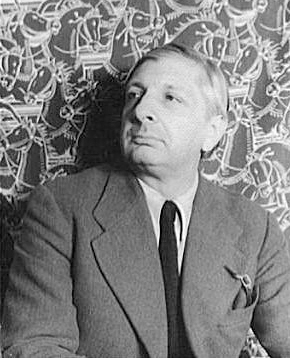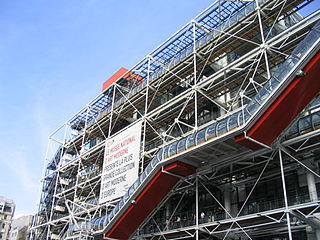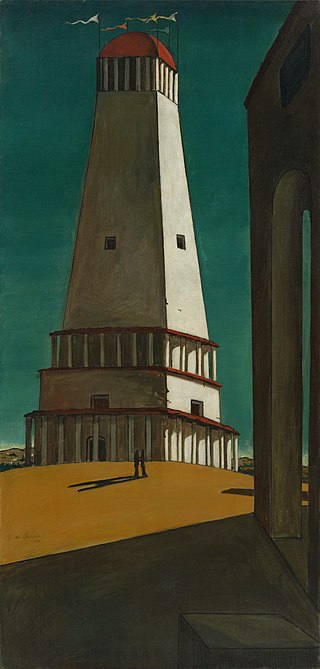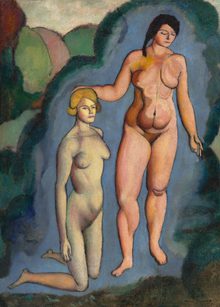
Giuseppe Maria Alberto Giorgio de Chirico was an Italian artist and writer born in Greece. In the years before World War I, he founded the scuola metafisica art movement, which profoundly influenced the surrealists. His best-known works often feature Roman arcades, long shadows, mannequins, trains, and illogical perspective. His imagery reflects his affinity for the philosophy of Arthur Schopenhauer and of Friedrich Nietzsche, and for the mythology of his birthplace.

The Musée National d'Art Moderne is the national museum for modern art of France. It is located in the 4th arrondissement of Paris and is housed in the Centre Pompidou. In 2021 it ranked 10th in the list of most visited art museums in the world, with 1,501,040 visitors. It is one of the largest museums for modern and contemporary art in the world.

Carlo Carrà was an Italian painter and a leading figure of the Futurist movement that flourished in Italy during the beginning of the 20th century. In addition to his many paintings, he wrote a number of books concerning art. He taught for many years in the city of Milan.
Walter Conrad Arensberg was an American art collector, critic and poet. His father was part owner and president of a crucible steel company. He majored in English and philosophy at Harvard University. With his wife Louise, he collected art and supported artistic endeavors.

The Nostalgia of the Infinite is a painting by Italian metaphysical painter Giorgio de Chirico, dated of 1911, but most likely painted in 1912-113.

The Song of Love is a 1914 painting by Italian metaphysical painter Giorgio de Chirico. It is one of the most famous works by Chirico and an early example of his pre-surrealist style, though it was painted ten years before the movement was "founded" by André Breton in 1924.
Ariadne was a figure in Greek mythology.

Gare Montparnasse (The Melancholy of Departure) (Italian: La stazione di Montparnasse) is an oil on canvas painting by the Italian metaphysical painter Giorgio de Chirico, from 1914. It is held at the Museum of Modern Art, in New York.

Giorgio Morandi was an Italian painter and printmaker widely known for his subtly muted still-life paintings of ceramic vessels, flowers, and landscapes—their quiet, meditative quality reflecting the artist's rejection of the tumult of modern life.

The Sleeping Ariadne, housed in the Vatican Museums in Vatican City, is a Roman Hadrianic copy of a Hellenistic sculpture of the Pergamene school of the 2nd century BC, and is one of the most renowned sculptures of Antiquity. The reclining figure in a chiton bound under her breasts half lies, half sits, her extended legs crossed at the calves, her head pillowed on her left arm, her right thrown over her head. Other Roman copies of this model exist: one, the "Wilton House Ariadne", is substantially unrestored, while another, the "Medici Ariadne" found in Rome, has been "seriously reworked in modern times", according to Brunilde Sismondo Ridgway. Two surviving statuettes attest to a Roman trade in reductions of this familiar figure. A variant Sleeping Ariadne is in the Prado Museum, Madrid. A later Roman variant found in the Villa Borghese gardens, Rome, is at the Louvre Museum.

Galka Scheyer was a German-American painter, art dealer, art collector, and teacher. She was the founder of the "Blue Four," an artists' group that consisted of Lyonel Feininger, Wassily Kandinsky, Paul Klee and Alexej von Jawlensky.

Georgios Roilos was one of the most important and influential Greek painters of the late 19th-early 20th century. He belonged to the so-called "Munich School". His major works include historical topics, portraits, and scenes of everyday life. One of his most famous paintings is “The Poets”, which depicts some of the most important representatives of the New Athenian school of poetry, also known as the Generation of 1880.

Morohashi Museum of Modern Art is an art museum that opened in Kitashiobara, Fukushima Prefecture, Japan, in 1999. It is situated within Bandai-Asahi National Park, near Goshiki-numa, and with views of Mount Bandai. The permanent collection includes over three hundred forty pieces by Salvador Dalí, which makes it the third largest Dalí Museum in the world and the sole Dalí Museum in Asia. It also owns works by other painters, like Sisley, Cézanne, Renoir, Matisse and Picasso.

The Battle of the Kearsarge and the Alabama is an 1864 oil painting by Édouard Manet. The painting commemorates the Battle of Cherbourg of June 19, 1864, a naval engagement of the American Civil War between the Union cruiser USS Kearsarge and the Confederate raider CSS Alabama. Many spectators were able to see the battle from the coast of France and saw the USS Kearsarge sink the CSS Alabama. Not having witnessed the battle himself, Manet relied on press descriptions of the battle to document his work. Within one month of this battle, Manet had already completed this painting and got it on display in the print shop of Alfred Cadart in Paris.
Lili Ország 8 August 1926 – 1 October 1978) was a Hungarian painter.
Michael R. Taylor is a curator, author, and expert in modern and contemporary art with a focus on Dada, Surrealism, and the work of Marcel Duchamp. With a Ph.D in Art History from the Courtauld Institute of Art in London, he was a Curator of Modern Art at the Philadelphia Museum of Art from 1997 until 2011, and Director of the Hood Museum of Art at Dartmouth College in Hanover, New Hampshire from 2011 until 2015 In May 2015, the Virginia Museum of Fine Arts announced its appointment of Dr. Taylor as Chief Curator and Deputy Director for Art and Education.

Ariadne is an oil and graphite on canvas 1913 painting by Italian painter Giorgio de Chirico, from 1913. It is held at the Metropolitan Museum of Art, in New York.

The Bush is a painting by Marcel Duchamp from 1910-1911. It is in the collection of the Philadelphia Museum of Art, that acquired it through The Louise and Walter Arensberg Collection in 1950. Its first owner was Dr. Raymond Dumouchel, himself the subject of another 1910 painting by Duchamp, Portrait of Dr. Dumouchel. One of the models may be Jeanne Serre, with whom Duchamp had a relationship and fathered a child, Yvonne, who later became known as Yo Savy. Duchamp noted that the painting marks the beginning of a practice of attaching non-descriptive titles to his work: "Introduce some anecdote without being 'anecdotal'"; the painting did not illustrate a definite theme, but the title created "the possibility to invent a theme for it, afterwards."

Fish Magic is a 1925 Surrealist painting by Swiss-German artist Paul Klee. The painting belonged to the collection of Walter and Louise Arensberg before being donated in 1950 to the Philadelphia Museum of Art where it is currently held.

Louise Belcourt is a Canadian-American artist based in New York, known for elusive, largely abstract paintings that blend modernist formal play, a commitment to the physical world, and a visual language that shifts between landscape and the body, architecture and geometric form. New York Times critic Ken Johnson writes of her earlier work, "balancing adroitly between Color Field abstraction and Pop-style representation, Ms. Belcourt's paintings invite meditation on the perceptual, the conceptual and how our minds construct the world." Describing her later evolution, David Brody writes in Artcritical, "Hard-nosed Canadian empiricism and Brooklyn grit seem to combine in Belcourt’s work to undermine stylistic stasis."
















